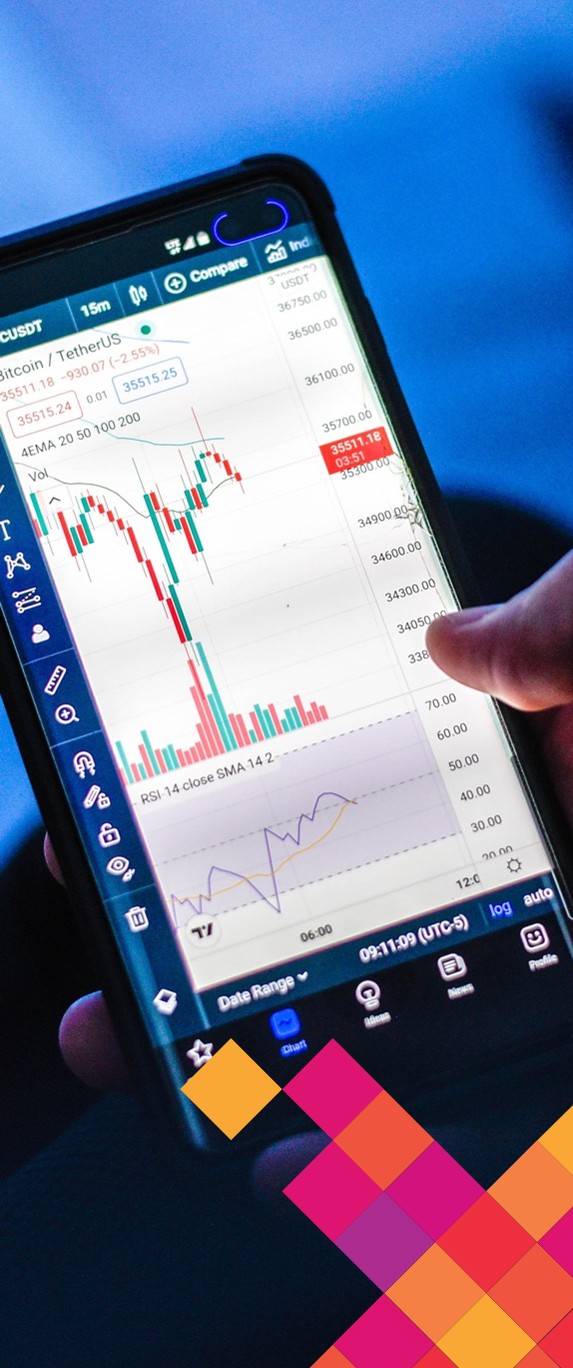In the following section, you will learn about the concept of lending, borrowing and staking.
Crypto lending refers to a function in DeFi that allows investors to lend their cryptocurrencies to different borrowers. This way, lenders receive interest payments in exchange, also referred as crypto dividends. Many platforms that specialize in lending crypto also accept stablecoins in addition to cryptocurrencies. Thus, cryptocurrencies go beyond being a payment method and can also act as an investment vehicle. When lending cryptocurrencies, it is important to note that one cannot access their cryptos while lending them out.
Example for lending
1
The lender owns 5 bitcoins and want to receive a steady passive income with them by depositing them into a crypto lending platform wallet.
2
Each month or week, the lender will receive interest (interest rates differ strongly based on the cryptocurrency and exchange).
Crypto lending works by taking crypto from one user and providing it to another for a fee. The exact method of managing the loan changes from platform to platform. There are crypto lending services on centralized and decentralized platforms, however, the core principles remain the same. In crypto lending, borrowers also have the chance to stake their cryptocurrency as guarantees of loan repayment or as security. Thus, the investors could sell the crypto assets in case the borrower does not pay off the loan
anymore. In this way, they can recover their losses. Lending and borrowing platforms do not usually have the chance to recover their losses since they ask borrowers to stake between 25-50% of the loan in crypto. Having a certain percentage staked makes sense if borrowers do not pay off their loans anymore. This way, the staked amount can be redeemed by the exchange in the case of an outfall.
Staking
If a cryptocurrency you own allows staking (e.g., Ethereum, Tezos, Cosmos, Solana, and Cardano) you can stake some of your holdings and earn a percentage-rate reward over time. The reason why cryptocurrencies earn rewards while staked is that the blockchain puts it to work. Cryptocurrencies that allow staking use the consensus mechanism PoS. If you stake your cryptocurrency, it becomes part of someone else’s share (or stake) in the network to increase the likeliness of validating the next block. While you can lend out all cryptocurrencies, staking is a concept exclusively for PoS-based cryptocurrencies.
How do crypto loans work?
Crypto lending usually involves three parties:
1
the lender,
2
the borrower,
3
and a DeFi platform or crypto exchange.

In most cases, the loan taker must provide collateral before being eligible for borrowing any crypto. An exception to this is flash loans which can be used without collateral. Lenders can then add their cryptocurrencies to a so-called pool that manages the whole process of lending for them and essentially forwards the lender their cut of the interest. Lending through centralized financial Fi platforms, as opposed to borrowing, works a little differently. Rather than lend all your money to just one individual, centralized exchanges use liquidity pools to lend your money out to multiple users at the same time. As a result, you are not informed whom your crypto is forwarded to, but the platform gives you a bond that underwrites your loans, making it a safe undertaking. Once such a loan expires, the bonds can be returned to recover the funds as well as any accrued interest.
Crypto lending rates
As mentioned, each platform has different rates for crypto lending. While there is a certain ROI for every crypto lending platform, there are also different risks depending on the platform of choice. Similar to investment strategies, crypto lenders tend to use several different platforms to spread the risks and diversify their investments.
When it comes to crypto lending, there is a yearly yield that can be expected

For crypto coins, it ranges from 3% to 8%,

For stablecoins, it ranges from 10% to 18%.
Different types of crypto loans
As mentioned, there are two types of crypto loans: flash loans and collateralized loans. We will focus on them in the next section.
Flash loans
Flash loans allow you to borrow crypto funds without the need for collateral. The name flash loan comes from the fact that the loan being granted, given, and repaid within a single block. If the loan amount cannot be returned including interest, the transaction is canceled before it can be validated in a block. From the outside, this looks like the loan never happened since it was never confirmed and added to the chain. A smart contract controls the whole process, making human intervention unnecessary.
With loans in traditional finance, the lender usually wants some kind of collateral to make sure they receive their money back. Setting up the contract often takes weeks or longer to get approved, and the borrower pays back the loan, with interest, over a period of weeks, months, or
years. Flash loans work diametrical to that. They occur in an instant because the funds are both borrowed and returned within seconds.
How does a flash loan work?
To use a flash loan, the parties involved need to act fast. This requirement is where smart contracts come into play again. With smart contract logic, you can create a top-level transaction containing sub-transactions. If any sub-transactions fail, the top-level transaction will not go through.
For the sake of the example, a token is trading for $1,00 (USD) in liquidity pool A and $1,10 in liquidity pool B. To take advantage of this (arbitrage), you currently do not have sufficient funds to purchase tokens from the first pool to sell in the second. A flash loan could help you to complete this arbitrage within one block. For example, imagine that for your primary transaction, you will take out a 2.000 USDC flash loan from a DeFi platform and repay it.
We can then break this down into smaller sub-transactions:
1
The borrowed funds are transferred to your wallet.
2
You purchase $2.000 of crypto from liquidity pool A (2.000 tokens).
3
You sell the 2.000 tokens for $1,10, giving you $2.200 in revenue.
4
You transfer the loan plus borrowing fee into the flash loan smart contract.
If one or more of these sub-transactions cannot execute, the lender would cancel the loan before it takes place. The most common use cases for flash loans include collateral swaps and price arbitrage. However, flash loan can only ever be used on the same chain, as moving funds to a different chain would break the one transaction rule.
Collateralized loans
A collateralized loan gives a borrower more time to make use of their funds in return for providing collateral. This type of loan is the backbone of open lending protocols. Given that DeFi is a synonym for open, pseudo-anonymous finance, credit score and formal identity checks associated with the loan are not part of the equation. Like mortgages, most DeFi lending applications will require borrowers to collateralize their loan as an incentive to hold them accountable for repaying the debt. While there are parallels, the main difference between a traditional mortgage loan and a collateralized loan on MakerDAO or Compound is that it requires the borrower to over-collateralize the loan.
MakerDAO is one example for a collateralized loan provider. Since cryptocurrencies are volatile, the loan-to-value ratio (LTV) reflects this volatility (the LTV is often only around 50%). This indicates that the loan will only be 50% the value of your collateral. This discrepancy is what provides wiggle room for collateral’s value in case it decreases. Once the collateral of the loanee falls below the loan's value or some other given value, the funds are automatically sold or transferred to the lender. It is necessary to top up the collateral if there is a change in price to avoid liquidation. If the LTF ratio becomes too high, there are fees to be paid. This monitoring is done by a smart contract. When the loan is repaid (plus interest) the loaner regains their collatera
Example
A 50% LTV loan of $10.000 USDC will require you to deposit $20.000 (USD) of ether (ETH) as collateral. If the value drops below $20.000, you will need to add more funds. If it falls below $12.000 you will be liquidated, and the lender will receive their funds back.
When someone takes out a loan, they will most likely receive newly minted stablecoins (such as DAI) or cryptocurrency someone has lent. Lenders will deposit their assets in a smart contract that may also lock up their funds for a specific time. Once the borrower receives the funds, they can utilize them for their purpose.

Advantages and disadvantages of crypto loans
Crypto loans have been commonly used tools in the DeFi space for years for various operations. In this section, you will look at the advantages and disadvantages of crypto loans:

| Advantages | Disadvantages | ||
| Easily accessible capital | Crypto loans are given to anyone who can provide collateral or return the funds in a flash loan. This quality makes them easier to acquire than a loan from a traditional financial institution, and there's no credit check needed. | High risk of liquidation | Even with highly over-collateralized loans, crypto prices can drop suddenly and lead to liquidation. |
| Smart contracts manage loans | A smart contract automates the whole process, making lending and borrowing more efficient and scalable. | Smart contract attack risk | Poorly written code and back-door exploits can lead to the loss of the loaned funds or collateral. Smart contracts and projects can be the targets of scams and attacks which could result in partial or complete loss of coins as well as the freezing of accounts, making withdrawal impossible. |
| Passive investment through vaults | Investors can place their crypto in a vault and earn annual percentage yield (APY) without managing the loan themselves. | Risk through borrowing & lending | The risks of lending and borrowing include the risks connected to handing over custody of crypto coins. What happens in which scenarios is usually part of the loan terms and conditions which should be studied in depth before loaning out crypto coins. Depending on the loan, the lock up period of the crypto coins can interfere with one’s ability to react to crypto market crashes and other market conditions. |
When Bitcoin was first launched in 2099, the only way to acquire bitcoin was by trading on forums or Internet Relay Chats, requiring a great deal of trust.
In March 2010, the first cryptocurrency exchange called bitcoinmarket.com went live. A user of the Bitcointalk forum named “dwdollar” proposed to create the first real market for people to buy and sell bitcoins with each other. The need for a useful pricing system as a starting point arose which was supposed to be based on the energy requirement for mining. In 2010, Bitcoinmarket.com, started with a price at launch of around $0,003 per Bitcoin. Bitcoinmarket.com used PayPal to exchange fiat money to Bitcoin but was removed after increasing fraudulent trades in June 2011 when Bitcoins price hit $23,99. Bitcoinmarket.com was certainly an
improvement from exchanging Bitcoin on forums but started to see competing exchanges gain popularity.
Mt. Gox & Early Platforms
In 2010, Jed McCaleb developed Mt. Gox. The initial name of the exchange was mtgox.com which is a reference to the digital collectible card game “Magic: The Gathering Online eXchange”. Within the next three years, 70% of all bitcoin trades were being handled via the Mt. Gox platform. McCaleb started to use the site to exchange USD for Bitcoin. Soon after the successful initiation period, he sold Mt. Gox off to another active executive. Regarding Mt. Gox there are several different records of fraudulent business operations. Missing funds, hacks and legal disputes were just the tip of the iceberg.
Examples for fraudulent business operations
According to court documents dating back to the time that Mt. Gox was sold off, 80.000 bitcoins were already missing which was followed by the first of several hacks where a total of 2.650 BTC were stolen. Nonetheless, the site gained traction and become the world’s largest bitcoin exchange by 2013. Mt. Gox proved to have severe website coding issues and poor security measures which facilitated attacks. The US Department of Homeland Security accused them of acting as an unregistered money transmitter which resulted in over $5 million USD seized by the US government from the company’s bank accounts. In turn, this leaded to the suspension of USD withdrawals and long delays for customers of Mt. Gox. In 2024 the situation faltered. A few weeks later, Mt. Gox suspended all trading for customers, the website went offline, and it filed for bankruptcy protection. The reason was an ongoing hack for years which amounted to 844.408 Bitcoins stolen from the hot wallets of customers that could not be recuperated.

The Mt. Gox management claimed to have been unknowledgeable about the missing funds. Karpelès, McCaleb’s successor, was indeed charged with fraud and embezzlement however, the aftermath (such as lawsuits) of the hack is yet to come to an end. Users can expect a certain return of their lost funds in the form of USD, however, the lost profit on their bitcoins since purchase will not be reimbursed.
The example of Mt. Gox highlights the risk landscape of centralized exchanges being reintroduced into a decentralized money vision perfectly. Mt. Gox is only the most notable example of crypto exchanges that later were sued for various reasons of business misconduct. Regulation only grew from negative examples such as Mt. Gox. Equivalent measures, laws and code of conduct that already exist for traditional finance had and still must be introduced for DeFi. Mt. Gox has served as a painful lesson that gives origin to the credo of Bitcoiners preaching “not your keys, not your coins”. The credo has also proven wise in more recent development around one of the biggest crypto exchanges worldwide, namely FTX, until they too filed for bankruptcy due to fraudulent business operations involving customer funds.

Current Developments
In March 2010, the first cryptocurrency exchange called bitcoinmarket.com went live. A user of the Bitcointalk forum named “dwdollar” proposed to create the first real market for people to buy and sell bitcoins with each other. The need for a useful pricing system as a starting point arose which was supposed to be based on the energy requirement for mining. In 2010, Bitcoinmarket.com, started with a price at launch of around $0,003 per Bitcoin. Bitcoinmarket.com used PayPal to exchange fiat money to Bitcoin but was removed after increasing fraudulent trades in June 2011 when Bitcoins price hit $23,99. Bitcoinmarket.com was certainly an
In 2018 and 2019, the rest of the crypto exchange market worldwide tried to catch up and regain market share. As a general trend, some exchanges such as Binance have given out their own their own utility token called BNB. It acts primarily as a discount token to pay for trading fees on the Binance exchange and to pay for goods and services. Similar loyalty-based incentives, so-called IEOs (Initial Exchange Offering), were introduced by projects to try and gain and retain customers. They have taken precedence over the ICO launches of prior years. Through IEOs, successful projects then received instant availability on a large exchange from day one, the exchange were able to determine the future exchange fees right away and also benefited from the IEO raise being denominated in their own exchange token. Crypto exchanges
Exchanges around the world
According to CoinMarketCap, there are more than 13.000 exchanges listed with a growth trend. Jurisdictions are beginning to regulate and establish specific rules for the operations of the exchanges. South Korea and Japan are rather progressive and most open to these platforms as long as they comply with certain rules focused on transparency and avoiding money laundering. Switzerland, Estonia, and Malta are the ones that provide the most facilities when it comes to establishing exchanges and other projects based on cryptocurrencies, because they have clear laws that must be complied with and that seek to protect users. The United States supports and controls the exchanges, although it does not have clear rules in favor or against it, and the position is quite ambiguous despite exchanges being allowed to operate.
Exchanges in Europe
Bitstamp is the first exchange developed and based in Europe and located in Luxembourg and was founded by Nejc Kodric in 2011. It is highly valued and operates globally. LocationBitcoins is the most reputed European crypto exchange today and one that moves the highest funds in their business operations on a European level. It was founded by brothers Nicholas and Jeremias Kangas in Helsinki, Finland in 2012. CEX.io is a UK based exchange bureau and was founded in 2013 by Oleksandr Lutskevych. CEX.io are known for adding new cryptocurrencies to their product portfolio frequently.


Exchanges in the United States
In the US, the crypto exchange Kraken, based in San Francisco, was the first US-American crypto exchange founded in 2011 by Jesse Powell. It has great prestige and as compared to other US exchanges, it moves the largest volumes of Bitcoin every day. Coinbase is also a San Francisco -based exchange founded in June 2012 by Brian Armstrong. The exchange Bittrex is based in Seattle and was founded in 2013. It offers option pairs with US dollars. Poloniex in Delaware, United States and founded by Tristan D'Agosta in January 2014, is one of the most demanding when it comes to adding cryptocurrencies and offers high-security measures to protect users.
Exchanges in Asia
In the Asian market, there is Bitfinex which is Hong Kong-based and was founded in 2012 by Raphael Nicolle and Giancarlo Devasini. It is characterized by being reliable and safe, benefitting from first mover advantage. It is the second largest in terms of volume of Bitcoin movements. Huobi is a Singapore-based exchange founded in 2013 by Leon Li and has the largest volume of Bitcoin and other cryptocurrencies in the market. Okex is an exchange house founded in 2013 by Star Xu based in Beijing, China. It is the third in volume of exchange of BTC and the first in Ethereum and EOS, among others. Binance was founded in 2017 by Chanpeng Zhao and is based in Shanghai, China. It is the one with the largest volume of Bitcoin today.
